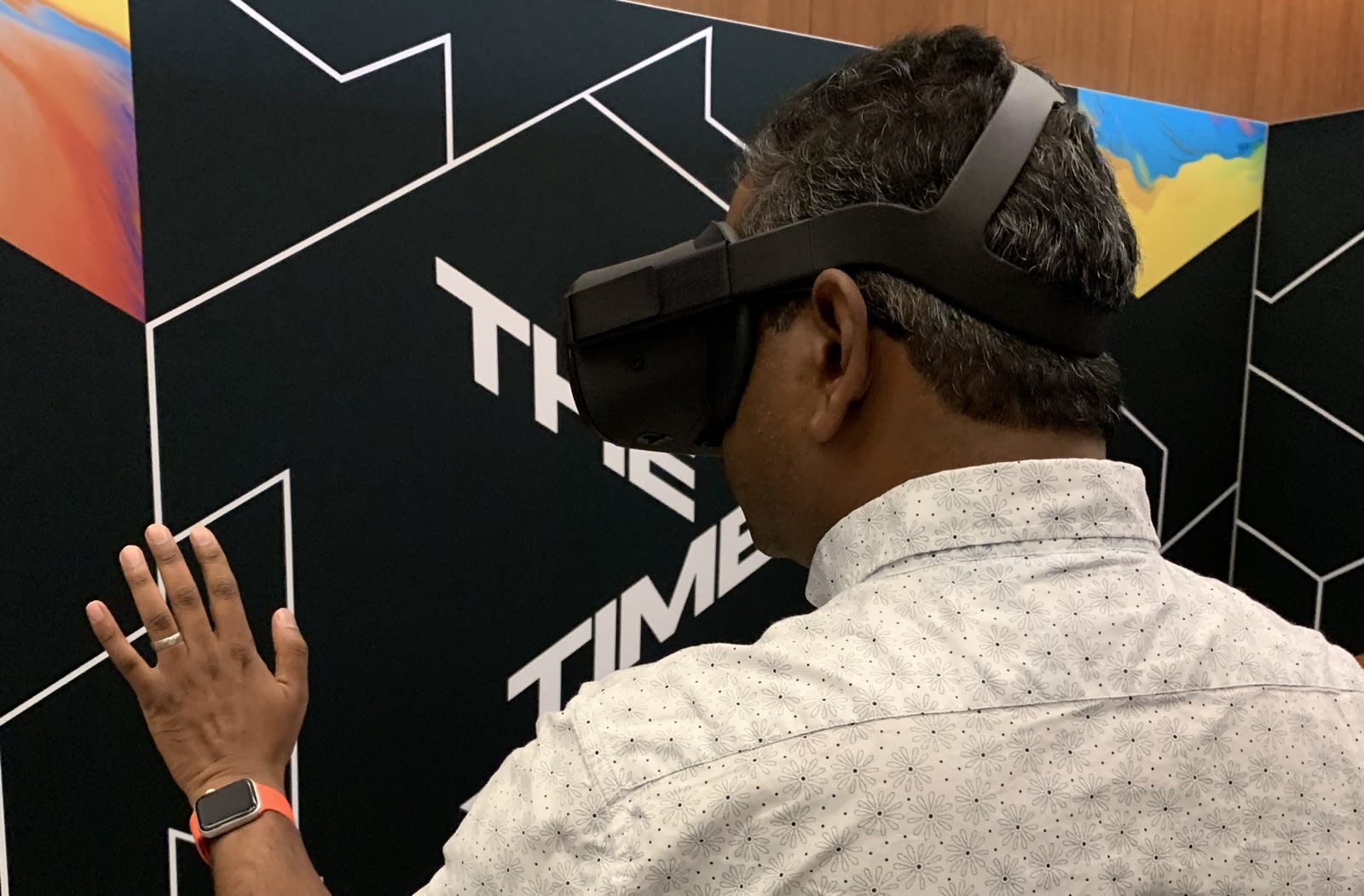Tag Archives: hand tracking
Oculus Quest hand tracking is available as an experimental feature
 You don't have to wait until 2020 to try Oculus Quest hand tracking, at least so long as you're willing to accept some limits. Oculus is trotting out the controller-free input method as an option in the "Experimental Features" menu this week. You c...
You don't have to wait until 2020 to try Oculus Quest hand tracking, at least so long as you're willing to accept some limits. Oculus is trotting out the controller-free input method as an option in the "Experimental Features" menu this week. You c...
Oculus Quest’s hand tracking is a new level of VR immersion
 Even though we had an inkling Oculus was working on hand tracking, it was still a huge surprise to see just how it would be implementing the feature. It'll be coming to the Oculus Quest next year — but best of all, it doesn't require any additi...
Even though we had an inkling Oculus was working on hand tracking, it was still a huge surprise to see just how it would be implementing the feature. It'll be coming to the Oculus Quest next year — but best of all, it doesn't require any additi...
Razer’s VR Headset to Include Leap Motion Hand Tracking Sensor

As a manufacturer of all-things-gaming, Razer couldn’t have missed the VR revolution. In order to distinguish itself from the competition, Razer plans to integrate Leap Motion hand tracking into its future VR headset.
In order to qualify as some sort of reality, VR should include by default interaction with the surrounding objects in the virtual space. Without presence, the whole immersion concept is brought down exclusively to the visual experience, and that’s not always very satisfactory. Let’s face it, controlling things with your hands in virtual reality is much better than using a controller. If we are to leave the real world for the virtual one, the experience needs to be complete, and that’s exactly what Razer wants to do by implementing the Leap Motion hand tracking sensor in its VR headset.
There’s always the option to get any other VR headset you like and buy the Leap Motion hand tracking sensor separately. That could turn out not only more expensive, but also less convenient to use. Fortunately, Leap Motion has announced that it would cooperate with Razer’s OSVR to put the hand tracking sensors right into the headset.
Leap Motion sensors will be provided in the form of an optional faceplate in OSVR’s hardware developer kit, which means that if you don’t need or want these sensors, you could always opt for the OSVR headset that comes without them.
This implementation is not better only for the consumers, but also for the devs, who no longer have to code for multiple platforms. From a user’s standpoint, the experience is more seamless.
Keep in mind that Leap Motion did not offer exclusivity to Razer, and in fact, it wants to collaborate with other companies from the VR industry, in order to bring the sensors to more VR headsets.
“Using your hands is not only the most natural method, it’s also the most intuitive,” said Michael Buckwald, Leap Motion’s CEO and co-founder. “I love that feeling of ‘Wow, my hand is in the computer.’ When that happens, there’s connection and magic,” added David Holz, Leap Motion’s CTO and other co-founder.
While consumers might have to wait a while till they get their mittens on a Leap Motion-equipped VR headset, it’s good to know this is really happening. Pre-orders for the OSVR headset will be live in May, with shipping expected to start in June.
Be social! Follow Walyou on Facebook and Twitter, and read more related stories about the Pinc headset that puts VR at your fingertips, or the MindLeap thought-controlled VR system.
Microsoft Research crafts wrist-worn device that tracks hand gestures in 3D space (video)
A team led by researchers at Microsoft's UK-based R&D lab has crafted a system that tracks the full 3D pose of a user's hand without the need for a pesky glove. Dubbed Digits, the Kinect-inspired rig latches onto a user's wrist and utilizes a diffuse infrared light, IR laser, camera and inertial measurement unit to track fingertips and just five key points of a hand. Leveraging a pair of mathematical models developed in-house after studying the mechanics of the human hand, the group uses the captured data to extrapolate the position of a user's paw. The team envisions the solution as a supplement to touch-based interfaces, a method for eyes-free control of mobile devices and as a gaming controller that could work in conjunction with Kinect or similar systems. In its current state, the device is composed of off-the-shelf parts and needs to be tethered to a laptop, but the ultimate goal is to create a mobile, self contained unit the size of a wrist watch. Hit the break to catch a video of the setup in action or tap the second source link below for more details in the group's academic paper.
Filed under: Misc
Microsoft Research crafts wrist-worn device that tracks hand gestures in 3D space (video) originally appeared on Engadget on Tue, 09 Oct 2012 09:50:00 EDT. Please see our terms for use of feeds.
Permalink New Scientist |
New Scientist |  Microsoft Research, ACM | Email this | Comments
Microsoft Research, ACM | Email this | Comments Qualcomm demos touch-free gesture control for tablets powered by Snapdragon (video)
Tablets are for touching -- that much is understood. But Qualcomm's making it so your fingers will be mostly optional, thanks to the Kinect-like powers of its Snapdragon CPU. To highlight this, the company's uploaded a couple of videos to its YouTube channel that showcase two practical use case scenarios for the gesture tech: gaming and cooking. Using the device's front-facing camera, users will one day soon be able to control onscreen avatars, page forward and back through recipes, setup profiles and even wake their slates all with simple hand or head movements. Alright, so tactile-free navigation of this sort isn't exactly new, but it does up open up the tablet category to a whole new world of innovation. Head past the break to peek the demos in action.
Continue reading Qualcomm demos touch-free gesture control for tablets powered by Snapdragon (video)
Filed under: Tablet PCs, Software
Qualcomm demos touch-free gesture control for tablets powered by Snapdragon (video) originally appeared on Engadget on Mon, 06 Aug 2012 16:22:00 EDT. Please see our terms for use of feeds.
Permalink Notebook Italia (Translated) |
Notebook Italia (Translated) |  MobiFlip (Translated) | Email this | Comments
MobiFlip (Translated) | Email this | Comments 
